Applied Wireless Identifications Group R26EA011 LR-911 and 2010AR RFID Reader User Manual MPR 2010AR Manual
Applied Wireless Identifications Group Inc. LR-911 and 2010AR RFID Reader MPR 2010AR Manual
Contents
Users Manual
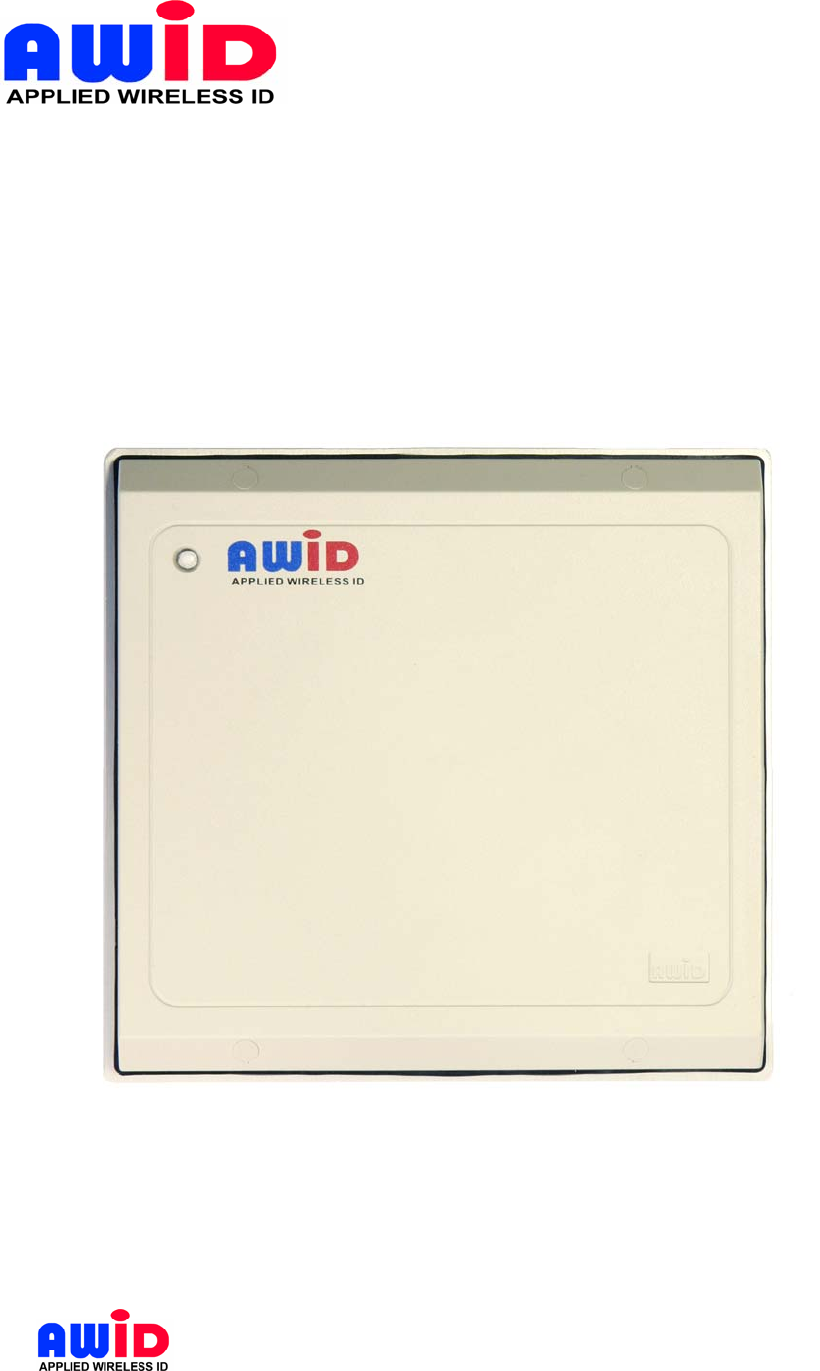
MPR-2010AR Page 1 Doc# 041308
AWID PROPRIETARY
SENTINEL-SENSE MPR-2010AR
Installation & Operation Manual-041308

MPR-2010AR Page 2 Doc# 041308
AWID PROPRIETARY
COPYRIGHT ACKNOWLEDGEMENTS
The contents of this document are the property of Applied Wireless Identifications Group, Inc.
(AWID) and are copyrighted. All rights reserved. Any reproduction, in whole or in part, is
strictly prohibited. For additional copies of this document please contact:
AWID
382 Route 59, Section 292
Monsey, NY 10952
www.sales-ast@AWID.com
The information contained herein has been carefully checked and is believed to be accurate,
no responsibility is assumed for inaccuracies. AWID reserves the right to make changes
without prior notice. This document is not covered by any warranty either expressed or
implied. Any comments, corrections or additions to the contents of this document should be
directed to AWID at the above address.
Copyright 2003 AWID, Printed in USA.
All other trademarks are the property of their respective owners.
FCC COMPLIANCE
This equipment has been tested and found to be in compliance with the limits for FCC Part 15,
Class A digital device. These limits are designed to provide reasonable protection against
harmful interference when the equipment is operated in a commercial environment. This
equipment generates, uses and can radiate radio frequency energy and, if not installed and
used in accordance with instruction manual, may cause harmful interference with radio
communications. Operation of this equipment in a residential area is likely to cause harmful
interference in which case the user will be required to correct the interference at his own
expense.
The users are prohibited from making any change or modification to this product, any
modification to this product shall voids the user’s authority to operate under FCC Part 15
Subpart A Section 15.21 regulations.
“This device complies with Part 15 of the FCC Rules. Operation is subject to the following
two conditions: (1) This device may not cause harmful interference and, (2) this device must
accept any interference received, including interference that may cause undesired
operation.”
INDUSTRY CANADA COMPLIANCE
Operation is subject to the following two conditions: (1) this device may not cause
interference and (2) this device must accept any interference, including interference that
may cause undesired operation of the device.

MPR-2010AR Page 3 Doc# 041308
AWID PROPRIETARY
CAUTION:
Reader should be positioned so that personnel in the area for prolonged periods may
safely remain at least 23 cm (9 in) in an uncontrolled environment from the reader’s surface.
Observe FCC OET Bulletin 56 “Hazards of radio frequency and electromagnetic fields” and
Bulletin 65 “Human exposure to radio frequency electromagnetic fields.”

MPR-2010AR Page 4 Doc# 041308
AWID PROPRIETARY
Table of Contents
1 INTRODUCTION....................................................................................................... 5
1.1 General Description & Theory of Operation ....................................................... 5
1.2 Special Features: ............................................................................................... 7
2 SPECIFICATIONS .................................................................................................... 8
2.1 Channel Frequency Table.................................................................................. 8
2.2 Input and Output Interfaces & Connector Pin Assignment................................. 8
2.2.1 Connector Pin Assignment.......................................................................... 8
2.3 Measuring Read Distance.................................................................................. 9
3 INSTALLATION & OPERATION GUIDELINES ..................................................... 10
3.1 Site Survey ....................................................................................................... 10
3.2 Preferred Reader Installation Practices............................................................ 10
3.3 Mounting Preference........................................................................................ 10
3.4 General Wiring Requirements.......................................................................... 10
3.5 Wiring Diagrams............................................................................................... 11
3.6 Grounding......................................................................................................... 11
4 INSTALLATION PROCEDURE .............................................................................. 12
4.1 Parts List .......................................................................................................... 12
4.2 Preparation for Installation ............................................................................... 12
4.2.1 Bench Top Verification.............................................................................. 12
4.2.2 Aiming of Antenna..................................................................................... 12
4.2.3 Mounting Considerations .......................................................................... 13
4.3 Installation Steps.............................................................................................. 13
5 SOFTWARE PROGRAMMING AND SYSTEM OPERATION NOTES .................. 14
5.1 System Operation............................................................................................. 14
5.1.1 Running a Custom Software Application or the AWID Demo Program .... 14
5.1.2 Operating Modes....................................................................................... 14
5.2 Users Note ....................................................................................................... 15
6 MPR SERIAL COMMUNICATION PROTOCOL..................................................... 15
NOTE: READ AND USE THIS MANUAL.
NOTE: FAILURE TO FOLLOW THE INSTALLATION GUIDE MAY RESULT IN
POOR PERFORMANCE OR EVEN CAUSE PERMANENT DAMAGE TO THE
READER, THUS VOIDS THE PRODUCT WARRANTY.

MPR-2010AR Page 5 Doc# 041308
AWID PROPRIETARY
1 INTRODUCTION
AWID's Sentinel-Sense MPR-2010AR is a long-range (12 to 15 feet) Radio Frequency
IDentification (RFID) reader with RS-232 I/O interface that works with most leading UHF
passive tags. This reader comes with a unique combination of long read range, small
size, and low power consumption. It has an internal power converter, allowing it to work
with a wide range of supply inputs without affecting its performance. Its primary
applications are asset management and tracking, and fleet management applications.
The MPR-2010AR readers are delivered with the following components and accessories:
CD containing interface document and demo SW
Power supply – PS9-2A-SW, 50-60 Hz and 110 to 220 VAC
In order to control the MPR-2010AR reader you will need the following:
PC running Windows1 98 or higher, CD-ROM drive and one RS-232 serial port.
Host software (AWID’s demo software or your own custom software).
RFID Tags (EPC Class 0, 1, ISO Type B or EM Micro, etc)
1.1 GENERAL DESCRIPTION & THEORY OF OPERATION
This reader uses radio frequency to identify, locate and track pallets and/or items that
carry the appropriate RFID transponders. It works in non-line-of-sight situations and in
darkness, bright sun-light, or through dirt, grime and smudges.
A typical RFID system consists of three components – a reader (interrogator), a
transponder (card or tag), and a data processing controller. The reader has an internal
micro-controller section, a transmitter section, a receiver section, and a circular
polarized transmit/receive antenna. Passive transponders (tags or labels) consist of an
antenna and an RFID ASIC (Application Specific Integrated Circuits). During operation,
the transmitter sends out an electromagnetic wave to establish a zone of surveillance.
When a transponder enters this zone, the electromagnetic energy from the reader
begins to energize the IC in the transponder. Once the IC is energized, it goes through
an initialization process and is ready to accept further commands. Upon receiving a
command that queries its identity, the RFID ASIC begins to broadcast its identity
through a low-energy back-scattering process, which selectively reflects or “back-
scatters” the electromagnetic energy to the interrogator. The receiving circuits in the
reader sense and decode this “back-scattered” signal and determine the identity of the
transponder.
Passive tags are “beam powered”, which is the electromagnetic energy radiated by the
transmitter section of the reader. Upon receiving a legitimated command, the tags will
cause the matching of the tags antenna to vary from match to mismatch, thereby
causing the tags to either absorb the RF energy or to reflect the RF energy. This
absorption or reflection sequence is commanded by the tags’ internal memory and this
•
1 Though MPR-2010AR can also be controlled from a non-Windows programming platform, AWID demo
and FW upgrade programs are applications to run in Windows.
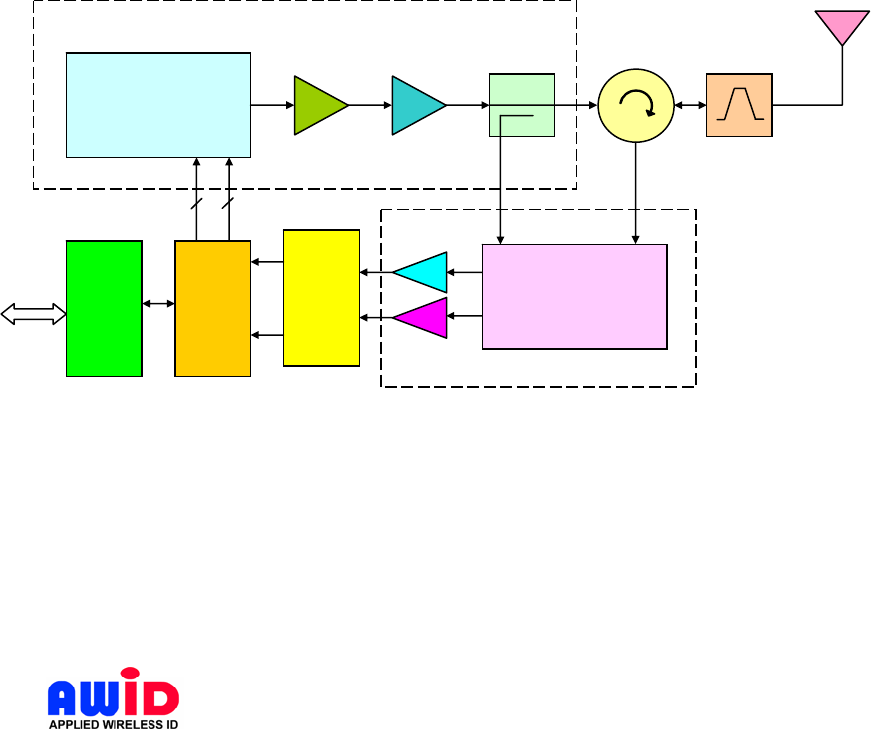
MPR-2010AR Page 6 Doc# 041308
AWID PROPRIETARY
is how the tags’ internal data are “conveyed” to the reader. The reader in turn monitors
the perturbation of the RF energy field, and thereby receives the varying degree of
signal reflected from the tags.
One of the unique design features for a (single-antenna) RFID reader is that it must
simultaneously transmit a strong CW signal and at the same time, receive a weak
reflected signal with little frequency separation. In a traditional design, such functions
are implemented through the use of a circulator. As shown in Figure 1, there is a 3-port
device between the Coupler and the band pass filter, which is called a circulator. A
circulator is physically constructed by a permanent magnet, a Y junction on a high-
dielectric ferromagnetic substrate, and a ferromagnetic enclosure to complete the flux
field. A circulator permits flow of RF energy in one direction only, e.g. from port 1 to 2, 2
to 3, and 3 to 1. When one of the ports is terminated (matched condition), the other two
are isolated in the reverse direction. Many fixed-site RFID readers use circulators to
ensure that the power amplifier output flows from the amplifier (port 1) to the antenna
(port 2), and the received signal flows from the antenna (port 2) to the receiver (port 3).
When properly matched, a circulator can provide typically 15 to 18 dB of isolation
between the power amplifier output (port 1) and the receiver input (port 3), thereby
reducing any in-band interference from transmitter output to receiver input. MPR-
2010AR uses a similar circuit to accomplish the same function, but in a much smaller
physical size.
Figure 1 Block Diagram, Single-Antenna RFID Reader
It should be noted that some fixed-site reader designs use separate transmit and receive
antennas to resolve this T/R signal isolation problem. Figure 2 is a block diagram of
such a dual-antenna RFID reader. On the surface, this design has the advantage of
allowing a low-level design on the receive chain, which means lower compression point
for mixers, lower saturation point for amplifiers, and the possibility of using a front-end
amplifier to enhance receiver sensitivity. Such dual-antenna design becomes
problematic in a mobile environment, where signal strength is not easily controlled. A
FREQUENCY
SYNTHESIZER
I/Q
DEMOD
Driver
AMP Power
AMP COUPLER XMIT/
RCVE
A/D
CPU I/O
XMT
R
CIRCULATO
R
BPF
RCV I
Q
RF
I
Q
I
Q
FRE
Q
AMPL
12
3
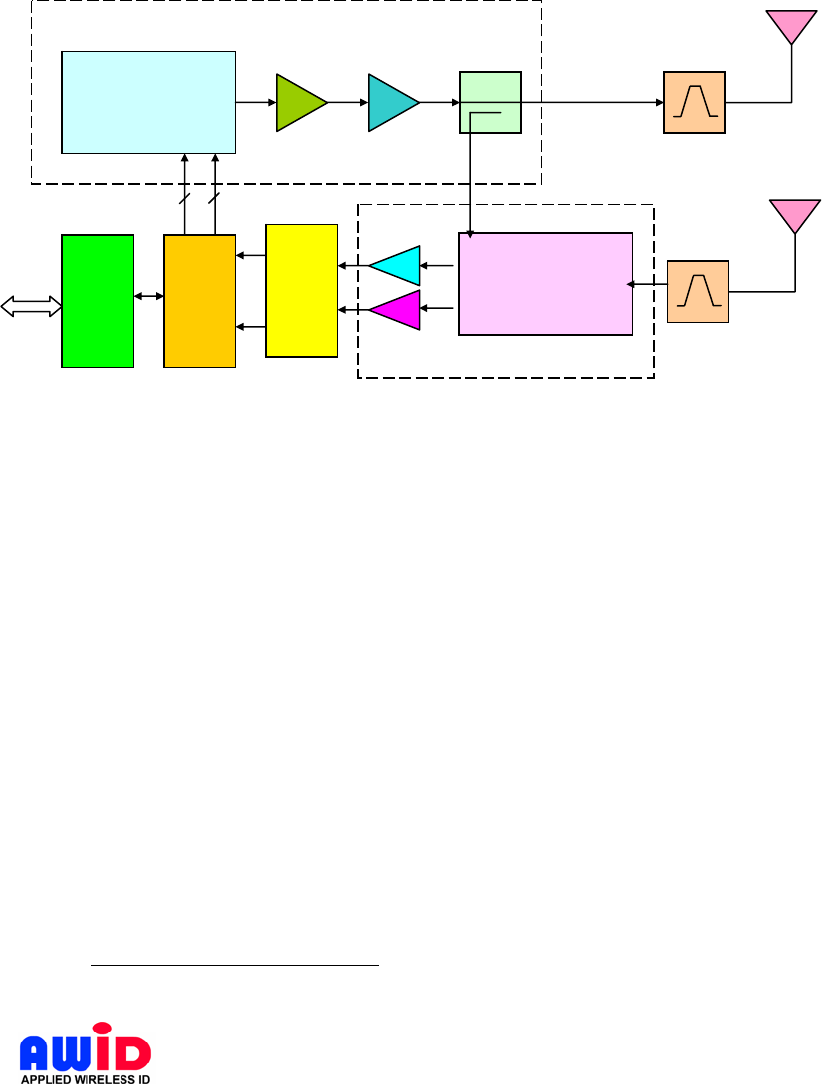
MPR-2010AR Page 7 Doc# 041308
AWID PROPRIETARY
well-designed dual-antenna reader can usually provide 25 to 30 dB of isolation between
the two signal paths, reducing the unwanted signal in the receive chain to –20 dBm.
However, when the RFID reader antenna is facing a tag placed on a large metallic
object at a distance of 12 inches, the reflected transmitter signal at the receiver input
can be as high as 13dBm, thereby eliminating any advantage of the dual-antenna
design.
In actual circuit implementation, AWID developed a proprietary circuit to duplicate the
functions of the circulator, with improved directivity and isolation.
Figure 2 Block Diagram, Dual-Antenna RFID Reader
1.2 SPECIAL FEATURES:
• Multi-Protocol: ISO-18000-6 Type B, EPC Class 12 Gen 1 & 2, EM Micro, EPC
Class 03, EPC V1.19 Rev.2
• Thin passive tags with long-range performance
• High performance circular polarized antenna
• RS-232 input/output
• Splash proof design for indoor or outdoor applications
• UV stabilized housing
•
2 Both 64- and 96-bit
3 Both 64- and 96-bit
RCVE
XMIT
RF Q
RCV
R
FREQUENCY
SYNTHESIZER
Driver
AMP Power
AMP COUPLER BPF
BPF
A/D
CPU
I/O
I
I/
Q
DEMOD
I
Q
I
Q
FRE
Q
AMPL
XMT
R
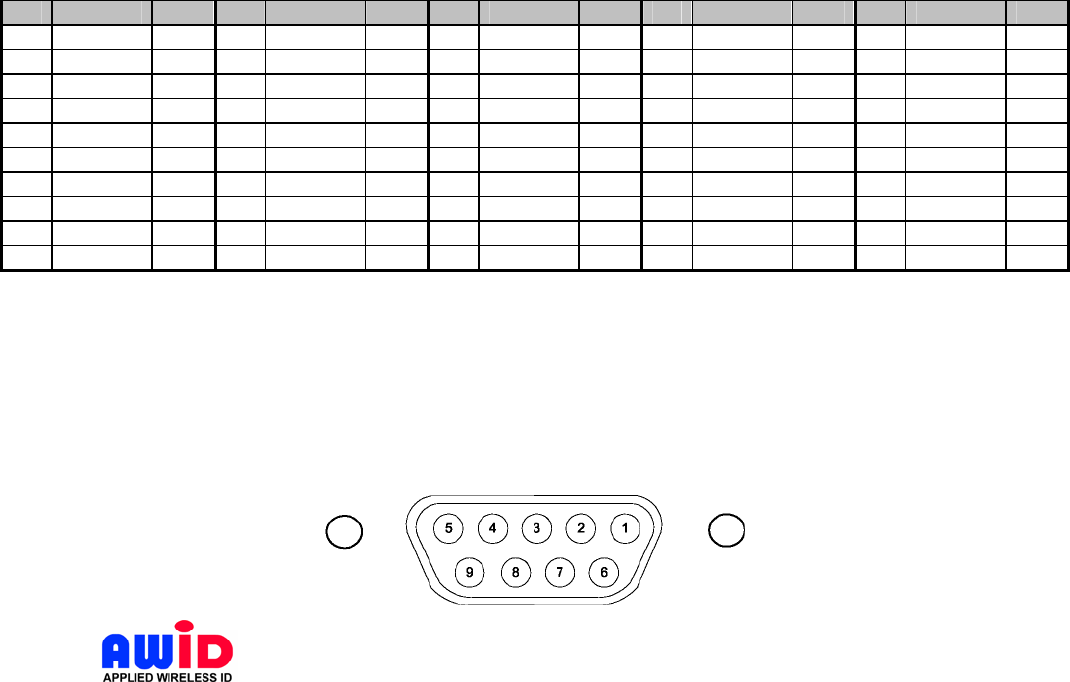
MPR-2010AR Page 8 Doc# 041308
AWID PROPRIETARY
2 SPECIFICATIONS
Input voltage +7.0 VDC to +15 VDC
Input current 1.0 A (7.0 V) to 0.40 A (15 V) typical
Protocol language ISO Type B, EPC Class 1 Gen 1 & 2, EM Micro,
EPC Class 0, EPC V1.19 Rev.2
Read range Depends on type & size of labels used
Output power 1.0 Watt into 6 dB antenna
Transmit frequency 902-928 MHz
Receiver frequency 902-928 MHz (Amplitude Modulated)
Hopping channels 50 Channels
Channel spacing 500 kHz
Hopping sequence Pseudo random
Operating temperature range -30° C to +65° C (-22° F to 149° F)
Color Beige
Output data format RS232
Dimension 8X9.5X1.125 inches (20X24X2.86 cm)
Weight
2.1 CHANNEL FREQUENCY TABLE
Frequency range: 902 ~ 928 MHz
Minimum Number of frequency channels: 50
CH 902~928 MHz CH 902~928 MHz CH 902~928 MHz CH 902~928 MHz CH 902~928 MHz
0 903.14 MHz 20 908.06 MHz 40 912.98 MHz 60 917.91 MHz 80 922.83 MHz
2 903.63 MHz 22 908.55 MHz 42 913.48 MHz 62 918.40 MHz 82 923.32 MHz
4 904.12 MHz 24 909.05 MHz 44 913.97 MHz 64 918.89 MHz 84 923.82 MHz
6 904.62 MHz 26 909.54 MHz 46 914.46 MHz 66 919.38 MHz 86 924.31 MHz
8 905.11 MHz 28 910.03 MHz 48 914.95 MHz 68 919.88 MHz 88 924.80 MHz
10 905.60 MHz 30 910.52 MHz 50 915.45 MHz 70 920.37 MHz 90 925.29 MHz
12 906.09 MHz 32 911.02 MHz 52 915.94 MHz 72 920.86 MHz 92 925.78 MHz
14 906.58 MHz 34 911.51 MHz 54 916.43 MHz 74 921.35 MHz 94 926.28 MHz
16 907.08 MHz 36 912.00 MHz 56 916.92 MHz 76 921.85 MHz 96 926.77 MHz
18 907.57 MHz 38 912.49 MHz 58 917.42 MHz 78 922.34 MHz 98 927.26 MHz
2.2 INPUT AND OUTPUT INTERFACES & CONNECTOR PIN
ASSIGNMENT
2.2.1 Connector Pin Assignment

MPR-2010AR Page 9 Doc# 041308
AWID PROPRIETARY
Pin Function Pin Function
1 Ground 6 +7V/+15V
2 RS232 Tx 7 +7V/+15V
3 RS232 Rx 8 Data 0
4 Enable RFID 9 Data 1
5 Ground 10 Ext Data in
2.3 MEASURING READ DISTANCE
Make sure you know the tag types. For certain readers and tags, user must also be
mindful of the tag’s orientation and the reader’s antenna orientation, what mounting
surface the tags are designed for and how the tags are supposed to be mounted. Any
departure from its intended purpose will drastically affect the reader’s ability to energize
the tag and its read range.
When measuring the reader’s read range, make sure that the tag is properly oriented to
the reader antenna, and for optimum performance, be sure the operator’s finger is not
within three (3) inches of the tag’s antenna surface.

MPR-2010AR Page 10 Doc# 041308
AWID PROPRIETARY
3 INSTALLATION & OPERATION GUIDELINES
3.1 SITE SURVEY
Always conduct a site survey before starting installation. Avoid any possible sources of
interference. For best result, use a spectrum analyzer with a wideband antenna and set
the spectrum analyzer in Max Hold mode to gain measurement of the maximum signal
strength on the airwave. If the MPR-2010AR reader is not installed properly, the
performance will be degraded. Listed below are steps that should be followed during
installation:
• Do not install reader in an area where sources of broadband noise may exist.
Avoid mounting the reader facing a cellular phone tower or in close proximity to the
base station of a 900 MHz wireless telephone.
• Keep all of the reader wiring a safe distance from all other wiring, including, but
not limited to, AC power, computer data wiring, and telephone wiring, and wiring to
electrical locking devices.
• Avoid operating the reader in close proximity to other 900 MHz wireless local
area networking (WLAN) equipment. It should be noted that MPR-2010AR readers
are known to work in electromagnetic crowded areas, such as trade shows.
3.2 PREFERRED READER INSTALLATION PRACTICES
• Avoid mounting the reader under direct sunlight. Exposure to direct sunlight may
cause the reader to operate at a temperature above the 65 degrees Celsius
upper limit.
• Make sure that the supply voltage of the reader is within specification
• Use cables with over-all shield (screen)
• For best results, avoid bundling data cable with AC power and computer cables
• Use the largest wire gauge where feasible
• Use dedicated power supply, where necessary
• Use Single Point Grounding, and avoid ground loops
3.3 MOUNTING PREFERENCE
MPR-2010AR has a uni-directional antenna with an antenna beam width of about 60-70
degrees. The radiation pattern is an oval-shaped beam, which should be aimed toward
where the transponders will pass.
3.4 GENERAL WIRING REQUIREMENTS
All the reader wiring should be continuously shielded. AWID recommends using #24
AWG up to #22 AWG, longer distances and higher current consumption on the power
supply line will require larger gauge wires. PG I/O output are standard access industry
Wiegand drivers, which is capable of 500 feet driving distance.
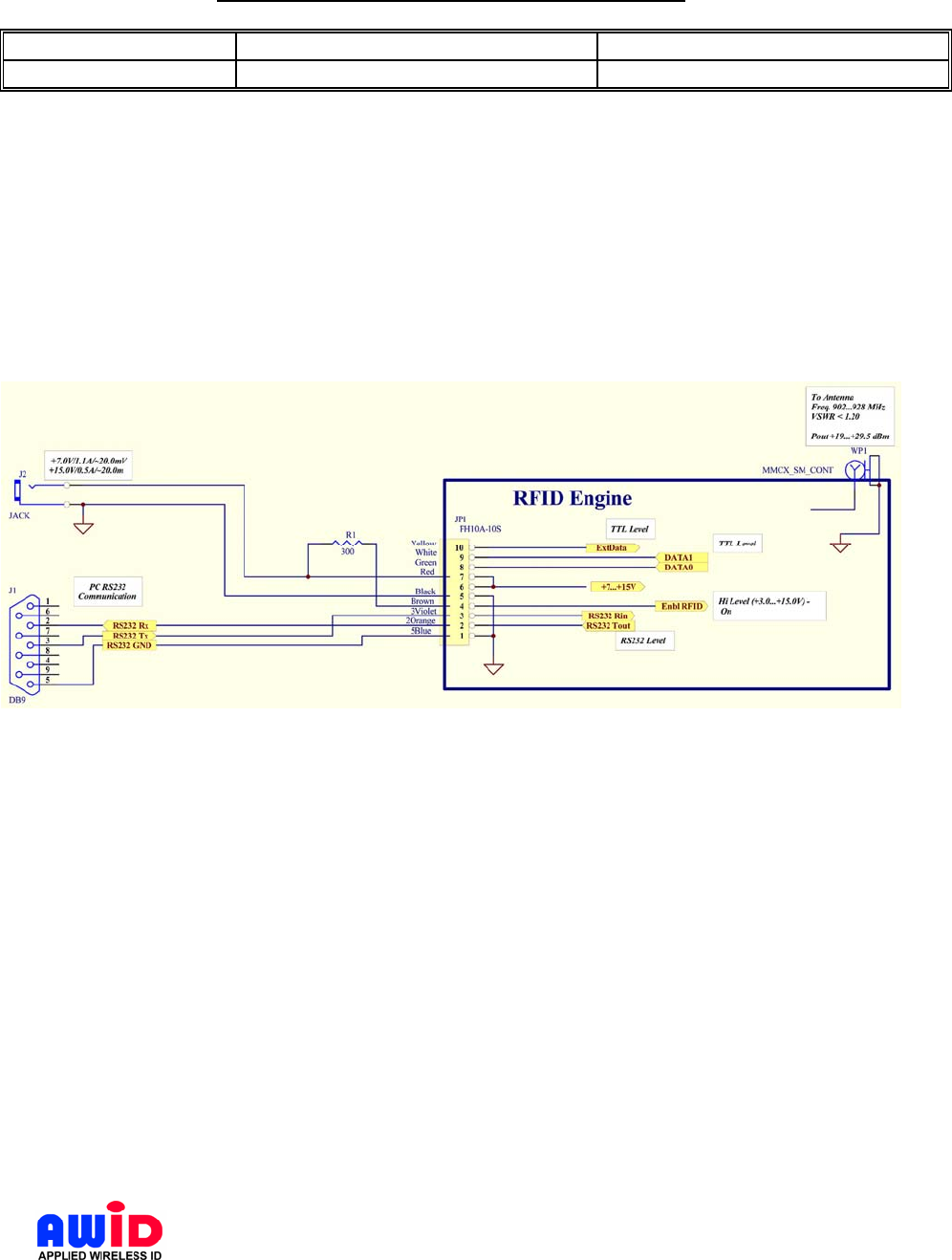
MPR-2010AR Page 11 Doc# 041308
AWID PROPRIETARY
TABLE 3.4-1: Data Line’s Wiring Requirement
WIRE SIZE #22 AWG (0.6 mm Dia.) #24 AWG (0.5 mm Dia.)
RS-232 50 ft (15 meters) 50 ft (15 meters)
3.5 WIRING DIAGRAMS
See section 2.1 for pin assignment for the RS-232 connector.
MPR-2010AR’s RS-232 interface is a short distance serial interface, a full command set
for the standard serial interface is not necessary, therefore only transmit, receive and
ground wires are used. Sense input is an enable input, which is traditionally used to
activate the RF energy of the reader and to start the read functions.
3.6 GROUNDING
Grounding is critical for proper operation of MPR-2010AR. When installing the reader, it
is crucial to assure that the earth ground is the best ground available. If you elect to use
the 120 VAC power ground, conduct a test by measuring its resistance relative to a
known good ground, such as a cold water pipe or structural steel that is in direct contact
with the ground. The resistance should be less than 50 ohms.

MPR-2010AR Page 12 Doc# 041308
AWID PROPRIETARY
4 INSTALLATION PROCEDURE
This section provides installation and operation information for MPR-2010AR readers.
4.1 PARTS LIST
Verify that all items listed below are present before starting the installation.
a. Sentinel-Sense MPR-2010AR reader Qty=1
b. Documentation and Demo Program CD Qty=1
c. LRMB – Reader mounting bracket (Optional)
4.2 PREPARATION FOR INSTALLATION
Familiarize yourself with the connectors and pin out assignment of each I/O connectors
as shown in section 2.2.1.
4.2.1 Bench Top Verification
It is always a good idea to verify system operation before committing to a full-scale
installation. The following are the necessary steps to test the reader’s operation in a
static environment.
Connect MPR-2010AR reader to the RS-232 port of a PC
Connect the power jack from the wall plug power supply to the MPR-2010AR
reader.
Power up PC
Install demo software on PC
Activate demo software and verify performance of the reader.
Select COM port 1 on top page then click “Connect”. Follow with some
commands.
Place the RFID tags at the exact same locations as the final configuration
Measure tag’s read distance and confirm that read distance is correct.
4.2.2 Aiming of Antenna
Antenna Pattern for MPR-2010AR
MPR-2010AR comes with a circular polarized antenna to ensure reading tag with
random orientation. Most circular polarized antenna has a horizontal to vertical
differential of up to 3 dB, this will cause the antenna pattern to deviate from a true circle.
AWID’s antenna has a horizontal to vertical differential of typically less than 0.5 dB,
making its pattern as near to a circle as possible.
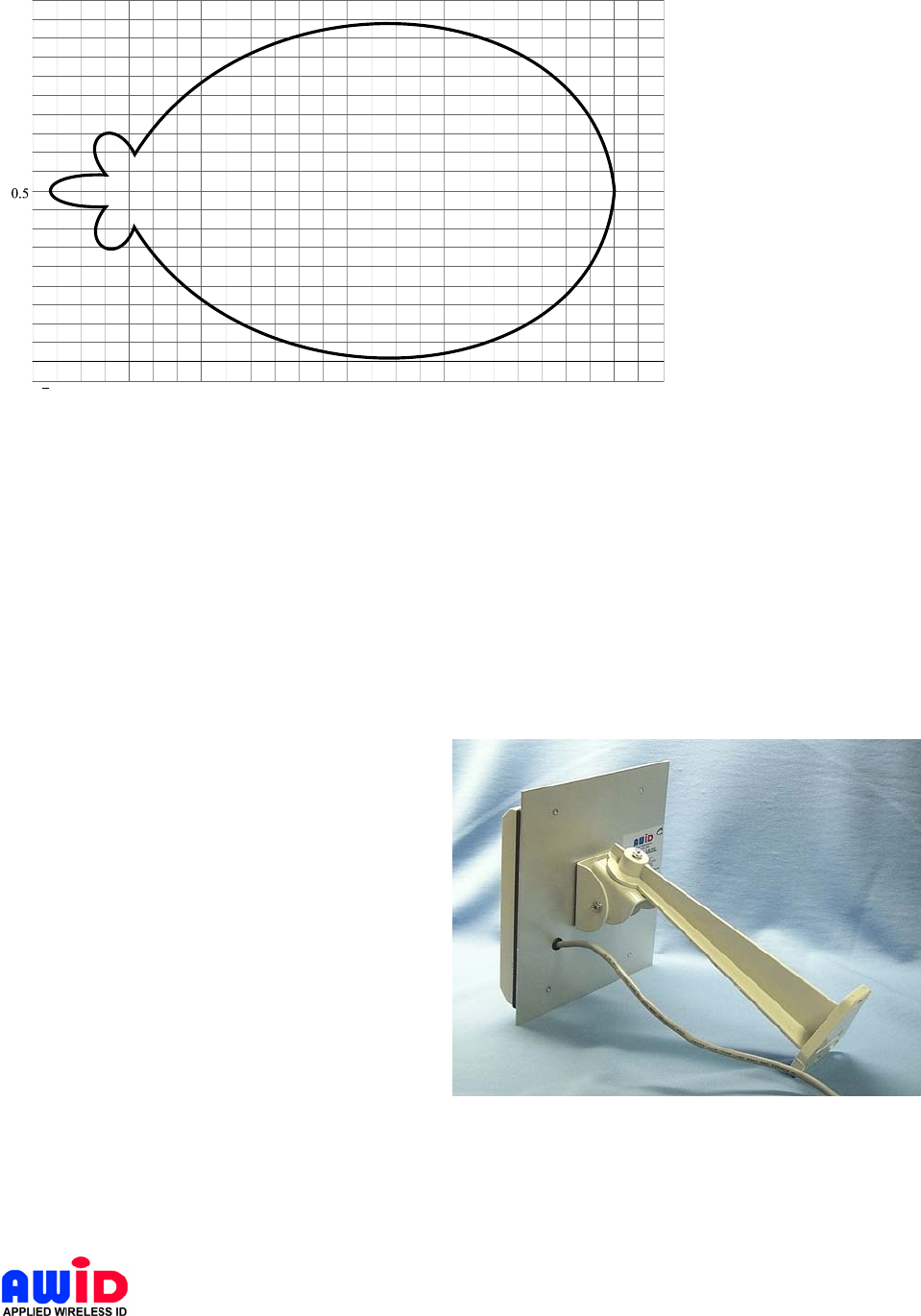
MPR-2010AR Page 13 Doc# 041308
AWID PROPRIETARY
0.15 00.25 0.5 0.75 R
0
Distance
(
R
)
Width( W)
W (0.72R)
Figure 3 - MPR 2010AR Antenna Pattern
• Antenna pattern measurements represent both horizontal and vertical polarized
planes of the read area transmitted by the reader.
• In the drawing above, R = approximately 12 feet to 15 feet for MPR-2010AR with
Alien free space tags.
• Antenna pattern can be affected by RFI and other environmental conditions.
4.2.3 Mounting Considerations
Antenna Mounting Bracket
Also available from AWID is an optional
antenna-mounting bracket (part # LRMB)
that provides antenna tilt adjustment and
pan adjustment. Photo at right shows
how the reader is mounted onto the
LRMB.
4.3 INSTALLATION STEPS
1) Check to ensure that all connections are secure. Make sure all wires through the
cable clamps are anchored properly. Avoid dangling wires that may become a
safety hazard.

MPR-2010AR Page 14 Doc# 041308
AWID PROPRIETARY
2) Mount the reader using the two recessed threaded holes to fasten to reader on
the desired mounting surface. Please note that the threaded inserts are closed-
ended, the user must select screws with the exact length to ensure proper
tightening of the mounting screws. In cases where the reader aiming is critical,
please order antenna-mounting bracket (P/N LRMB) from AWID. This mounting
bracket provides pan/tilt adjustment for the reader. Users can also drill holes
through the plate as required.
3) Adjust the position or the angle of the reader so that the tags are detected and
read at the desired distance from the reader.
5 SOFTWARE PROGRAMMING AND SYSTEM OPERATION NOTES
5.1 SYSTEM OPERATION
5.1.1 Running a Custom Software Application or the AWID Demo Program
If AWID Demo Program is not used, it is expected user will launch a Custom Software
Application developed using the MPR Serial Communication Protocol to send to reader
the commands as defined by the protocol.
5.1.2 Operating Modes
Typical operating modes for MPR-2010AR readers can be grouped into the following modes:
Search Mode
This mode is used when operator or user is not certain what family of tags is placed on
the items to be tracked. Since most tags are deterministic in nature, reader must cycle
through each and every protocol, issue a protocol specific inquiry, to hail and to wait for
a response from tags of that specific protocol. Therefore, if there are many different
protocols, for an untrained observer, the reader response will appear sluggish.
Mixed Mode
This mode assumes the user is aware of the types of protocol in use, and furthermore, the
user made a determined effort to operate the reader in a mixed protocol mode. In this
mode, the user can decide how many and which specific protocols to be selected. Once
Mix Protocol Mode is selected, the reader will routinely cycle through each protocol, dwell
long enough for the reader to wait for a response and then move on to the next protocol. It
should be noted that in a mixed protocol mode, the tag must have sufficient time to
respond to the reader, and therefore, it can only be used on a conveyor belt arrangement,
with specific speed restrictions.
Single Protocol Mode
Single protocol is the normal mode of operation, where the protocol type is known and
many tags are expected to pass through the readers.

MPR-2010AR Page 15 Doc# 041308
AWID PROPRIETARY
5.2 USERS NOTE
For System Integrators and/or Software Developers
System Integrators and/or Software developers should get familiar with the MPR Serial
Communication Protocol specifications for developing applications that control MPR-
2010AR readers.
For Custom System Users
For custom system user, please refer to your host software user guide for information
regarding system and software operations
For Demo Software Users
If you are using the AWID demonstration software application which is .NET based with
easy-to-follow GUI operations, simply select the COM port for which the reader is
configured then click Connect should get you started.
6 MPR SERIAL COMMUNICATION PROTOCOL
See MPR Serial Communication Protocol – Doc# 041300.